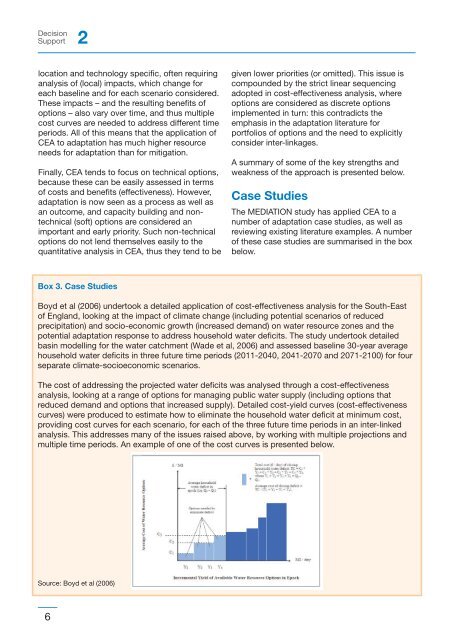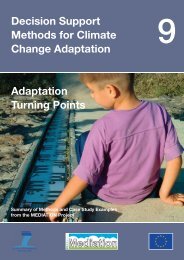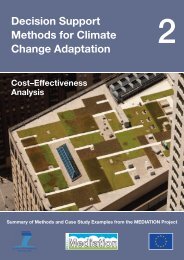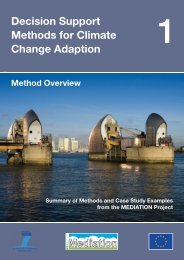Download all Technical Policy Briefing Notes in a single ... - Mediation
Download all Technical Policy Briefing Notes in a single ... - Mediation
Download all Technical Policy Briefing Notes in a single ... - Mediation
- No tags were found...
Create successful ePaper yourself
Turn your PDF publications into a flip-book with our unique Google optimized e-Paper software.
DecisionSupport 2location and technology specific, often requir<strong>in</strong>ganalysis of (local) impacts, which change foreach basel<strong>in</strong>e and for each scenario considered.These impacts – and the result<strong>in</strong>g benefits ofoptions – also vary over time, and thus multiplecost curves are needed to address different timeperiods. All of this means that the application ofCEA to adaptation has much higher resourceneeds for adaptation than for mitigation.F<strong>in</strong><strong>all</strong>y, CEA tends to focus on technical options,because these can be easily assessed <strong>in</strong> termsof costs and benefits (effectiveness). However,adaptation is now seen as a process as well asan outcome, and capacity build<strong>in</strong>g and nontechnical(soft) options are considered animportant and early priority. Such non-technicaloptions do not lend themselves easily to thequantitative analysis <strong>in</strong> CEA, thus they tend to begiven lower priorities (or omitted). This issue iscompounded by the strict l<strong>in</strong>ear sequenc<strong>in</strong>gadopted <strong>in</strong> cost-effectiveness analysis, whereoptions are considered as discrete optionsimplemented <strong>in</strong> turn: this contradicts theemphasis <strong>in</strong> the adaptation literature forportfolios of options and the need to explicitlyconsider <strong>in</strong>ter-l<strong>in</strong>kages.A summary of some of the key strengths andweakness of the approach is presented below.Case StudiesThe MEDIATION study has applied CEA to anumber of adaptation case studies, as well asreview<strong>in</strong>g exist<strong>in</strong>g literature examples. A numberof these case studies are summarised <strong>in</strong> the boxbelow.Box 3. Case StudiesBoyd et al (2006) undertook a detailed application of cost-effectiveness analysis for the South-Eastof England, look<strong>in</strong>g at the impact of climate change (<strong>in</strong>clud<strong>in</strong>g potential scenarios of reducedprecipitation) and socio-economic growth (<strong>in</strong>creased demand) on water resource zones and thepotential adaptation response to address household water deficits. The study undertook detailedbas<strong>in</strong> modell<strong>in</strong>g for the water catchment (Wade et al, 2006) and assessed basel<strong>in</strong>e 30-year averagehousehold water deficits <strong>in</strong> three future time periods (2011-2040, 2041-2070 and 2071-2100) for fourseparate climate-socioeconomic scenarios.The cost of address<strong>in</strong>g the projected water deficits was analysed through a cost-effectivenessanalysis, look<strong>in</strong>g at a range of options for manag<strong>in</strong>g public water supply (<strong>in</strong>clud<strong>in</strong>g options thatreduced demand and options that <strong>in</strong>creased supply). Detailed cost-yield curves (cost-effectivenesscurves) were produced to estimate how to elim<strong>in</strong>ate the household water deficit at m<strong>in</strong>imum cost,provid<strong>in</strong>g cost curves for each scenario, for each of the three future time periods <strong>in</strong> an <strong>in</strong>ter-l<strong>in</strong>kedanalysis. This addresses many of the issues raised above, by work<strong>in</strong>g with multiple projections andmultiple time periods. An example of one of the cost curves is presented below.Source: Boyd et al (2006)6





